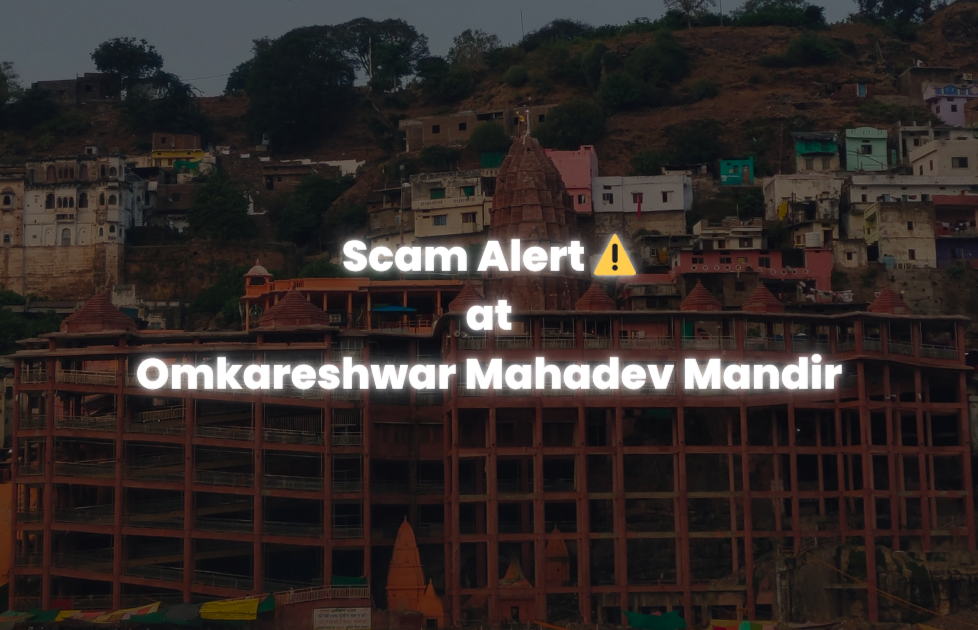Scam Alert at Omkareshwar Mahadev Mandir: A Tale of Exploitation, Mismanagement, and Local Complicity


The Omkareshwar Mahadev Mandir, revered as a pivotal site of Hindu pilgrimage, sits majestically along the Narmada River, drawing in a multitude of devotees each year. Known for its spiritual ambiance and religious significance, this ancient temple dedicated to Lord Shiva has recently become the center of a disconcerting scandal. A scam, deeply ingrained in the daily workings of the temple, has come to light, revealing a stark contrast to the temple’s esteemed legacy.
Devotees facing long queues are misled by imposters who offer faster entry for ₹500 per person, falsely claiming the fee supports the temple trust. An additional ₹500 is demanded as ‘Guru Dakshina’, purportedly for the gatekeepers and their own gain. These scammers misuse gates intended for Brahmins and trust members, further undermining temple protocols.
Attempts to capture evidence of these transactions were met with threats, as the scammers insisted on deleting any recorded material. (Thanks to OneDrive, I got my backups.)
Attempts to capture evidence of these transactions were met with threats, as the scammers insisted on deleting any recorded material. (Thanks to OneDrive, I got my backups.) Link Of some Videos and images.
Considering five devotees as an example:
On our journey back to Indore, a conversation with our cab driver shed light on the extent of local awareness and possible complicity in the scam. He candidly suggested that instead of pursuing engineering, one could earn significantly more by being part of these deceptive practices at the temple.
The cab driver’s comment suggests that this scam is not just an isolated act by a few individuals but is possibly a known issue among locals. This raises concerns about the role of local governance (Prashasan) and administrative bodies (Sasan) in addressing or overlooking these fraudulent activities. It appears that despite widespread knowledge of these scams, little to no action is taken to curb them, pointing to a concerning level of tolerance or even acceptance within the local community.
The persistence of this scam underlines a significant lapse in temple management. The inability of the temple authorities to detect and address such fraudulent practices raises questions about their vigilance and commitment to preserving the temple’s sanctity. This neglect has allowed a culture of deception to proliferate within the temple premises, tarnishing the temple’s reputation and the spiritual experience it promises.
The lack of effective measures to inform, warn, or safeguard devotees against these scams reflects poorly on the management’s role as custodians of a sacred site. Their silence and inaction could be construed as complicity, further eroding the trust that devotees place in the temple’s administration.
On our journey back to Indore, a conversation with our cab driver shed light on the extent of local awareness and possible complicity in the scam. He candidly suggested that instead of pursuing engineering, one could earn significantly more by being part of these deceptive practices at the temple. This remark was particularly striking since two of my friends traveling with me are Brahmins, indicating a deeper communal knowledge of these scams.
The cab driver’s comment suggests that this scam is not just an isolated act by a few individuals but is possibly a known issue among locals. This raises concerns about the role of local governance (Prashasan) and administrative bodies (Sasan) in addressing or overlooking these fraudulent activities. It appears that despite widespread knowledge of these scams, little to no action is taken to curb them, pointing to a concerning level of tolerance or even acceptance within the local community.
The scam at Omkareshwar Mahadev Mandir is a complex interplay of deceit, exploitation, and administrative negligence. It not only financially exploits the devotees but also mars the spiritual essence of their pilgrimage. This situation demands immediate attention and action from both the temple authorities and local governance. It is imperative to restore the sanctity and trust that define the Omkareshwar Mahadev Mandir, ensuring that it remains a revered place of worship, unmarred by the shadows of deceit and mismanagement.
DISCLAIMER: The author is solely responsible for the views expressed in this article. The author carries the responsibility for citing and/or licensing of images utilized within the text.
